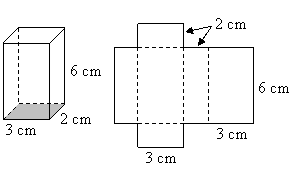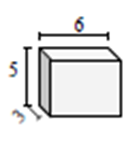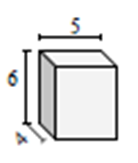
- Surface Areas
- Home
- Nets of solids
- Surface area of a cube or a rectangular prism
- Surface area of a rectangular prism made of unit cubes
- Distinguishing between surface area and volume
- Using a net to find the surface area of a rectangular prism
- Word problem involving the surface area of a rectangular prism
- Surface area of a triangular prism
- Using a net to find the surface area of a triangular prism
Using a net to find the surface area of a rectangular prism
In this lesson, we use nets of a solid figure to find the surface area of a solid figure.
The net of a solid figure is formed when a solid figure is unfolded along its edges and its faces are laid out in a pattern in two dimensions.
Nets of rectangular prisms are made up of rectangles and squares.
Using a net to find the surface area of a rectangular prism
Finding the areas of each of the rectangles and squares of the net of a rectangular prism and adding up those areas gives the surface area or total surface area of the prism.
For example, if the length of one side of the cube 4 units then the area of one its face is 4 × 4 = 16 square units. From the net, we can see that there are six equal faces and so we get the total surface area is 6 × 16 = 96 square units.
Surface Area of a Rectangular Prism using Nets
A rectangular prism or cuboid is formed by folding a net as shown −

We can see from the net that there are two rectangles with dimensions 3 cm by 6 cm, two rectangles with dimensions 2 cm by 6 cm and two rectangles with dimensions 2 cm by 3 cm. The total surface area is then
2 × 3 × 6 + 2 × 2 × 6 + 2 × 2 × 3 = 72 cm2
Find the surface area of the given rectangular prism in square cm.

Solution
Step 1:
Using net, the surface area of a rectangular prism
= 2(l w + w h + l h); l = 6 ; w = 5; h = 3
Step 2:
Surface area of given prism = 2(6 × 5 + 6 × 3 + 3 × 5)
= 2(30 + 18 + 15)
= 126 square cm
Find the surface area of the given rectangular prism in square cm.

Solution
Step 1:
Using net, the surface area of a rectangular prism
= 2(l w + w h + l h); l = 5; w = 6; h = 4
Step 2:
Surface area of given prism = 2(5 × 6 + 5 × 4 + 6 × 4)
= 2(30 + 20 + 24)
= 148 square cm